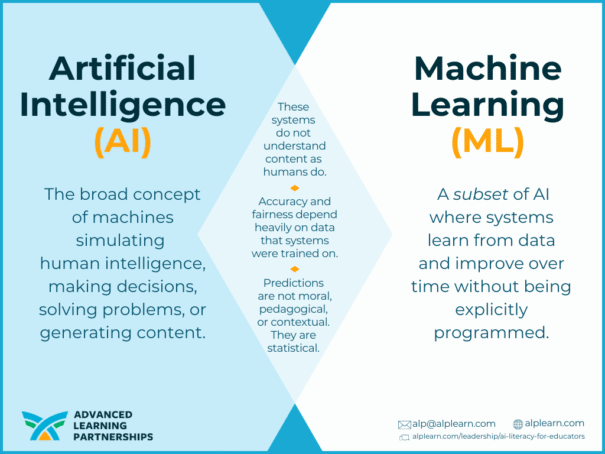We are in a unique moment in time. Educators have a chance to equip students not only to use AI but to understand it, challenge it, and shape its future. This isn’t just about preparing students for their future careers or accessing AI as a tutor for their current school work. Artificial intelligence is shaping nearly every sector of our world. Generative AI is being used to make weather predictions, generate news content, diagnose medical conditions, write code, and more. As we encounter AI-generated content more and more frequently, we have some important learning to do about how to interpret AI outputs, use AI tools ethically and effectively, and maintain our intelligence, creativity, and critical thinking in a world where technology can do these things at increasingly optimal levels.
“We are in a unique moment in time. Educators have a chance to equip students not only to use AI but to understand it, challenge it, and shape its future.”
The capabilities and prevalence of free generative AI tools create new questions for teachers about the importance of the knowledge and skills taught within their curriculum. Many educators are wondering what the consequences of learning from and with these tools might be. And, school systems are facing decisions about when, if, and how students are allowed to use AI. These are complicated questions that require thoughtful and intentional consideration. Having a foundational understanding of what AI is, what it can do, and what its limitations are will help educators make informed decisions now and in the future as the technology continues to progress. This article outlines some key ideas about bias, hallucinations, prompting, machine learning, and awareness of AI in our world. These ideas are not a comprehensive list encompassing AI literacy, but their applications to teaching and learning are meaningful and relevant to today’s educators.
One of the biggest pitfalls with generative AI is bias.
One of the biggest pitfalls associated with generative AI is bias. Understanding AI bias will empower teachers to decide how to leverage AI for workflows such as lesson planning or grading safely. Biases emerge from the data used to train AI models, which is often scraped from publicly available sources online. This data is a mix of accurate and inaccurate content that reflects societal biases. As tech companies scale their models, they prioritize quantity over quality, pulling in massive datasets without close scrutiny of representation or fairness. This can lead to skewed datasets that overrepresent certain demographics while underrepresenting diverse voices and perspectives.
Understanding AI bias helps a teacher recognize that, as a tool for grading, AI may score papers with bias based on writing style or cultural expressions. An AI score impacts a student’s grade, their perceptions about their understanding of the subject matter, and a teacher’s perception about what a student does or does not understand. Teachers who understand these risks can explore time-saving AI use cases, such as leveraging AI for feedback on student work with a critical evaluation for bias in the output. Ultimately, teachers are responsible for maintaining ethical grading practices that treat students fairly with or without the use of AI.
The Problem with hallucinations is that they sound compelling.
In addition to the problem of bias in AI, there are additional risks and limitations associated with using AI tools. Understanding these risks is part of the responsibility of using this technology.
- Hallucinations: AI models can generate content that is completely false, but sounds confident and persuasive. For example, citing non-existent articles or giving incorrect math explanations. Because these outputs sound reasonable, it is easy for users to trust the output rather than critically question it.
- Lack of reasoning: These tools don’t think, they predict. They do not reason or understand context the way a human does. How teachers position AI to students today will inform how students approach this technology going forward.
- No lived experience: AI cannot draw on emotion, empathy, or real-world judgment. Educators must continue to infuse these human qualities into their instruction and resources.
Teachers need to be aware of these limitations not only to evaluate AI use in their work but to teach students to verify, cross-reference, and question the outputs they receive. If we don’t take time to educate students about AI and its associated vulnerabilities, they will operate AI tools out of convenience instead of with intentional purpose.
Prompt design is a powerful entry point to engage critically with AI.
We know the hype around AI: it can save time, personalize learning, and generate engaging lessons. Those benefits may be true when teachers understand how to craft clear, specific, and purposeful prompts. One of the most practical skills in working with generative AI is prompting.
A well-phrased prompt can turn an average output into something useful and creative. Understanding how to structure a prompt and the subsequent chat thread helps users leverage their expertise while gaining insights that would not have been possible with the current time, resource, and knowledge constraints.
Teaching prompt design is a powerful entry point for students to engage critically with AI. It requires clarity, curiosity, and purpose—all skills that we want students to develop in every content area. There are school-based AI tools that allow students and teachers to use generative AI with limited prompting knowledge. While these tools may be convenient, students may be accessing other LLMs outside of school, or these tools may be cost-prohibitive. Developing prompting skills will prepare both students and teachers for shifting technological environments.
AI and Machine Learning
Understanding the hazards of AI is imperative to making informed decisions about using AI and applying its outputs. Along with the risks and responsibilities, foundational AI literacy includes knowledge about how the technology works. Artificial Intelligence is rapidly changing and becoming more capable of new functions. Educators who understand and follow along with these advances will be better equipped to integrate new and improved features into their workflow and to create healthy boundaries with the technology.
- Artificial Intelligence (AI) is the broad concept of machines simulating human intelligence, making decisions, solving problems, or generating content.
- Machine Learning (ML) is a subset of AI where systems learn from data and improve over time without being explicitly programmed.
Knowing that AI is often built on machine learning helps educators understand that:
- These systems don’t understand content like a human does.
- Their accuracy and fairness depend heavily on the data they were trained on.
- Their predictions are statistical, not moral, pedagogical, or contextual.
This awareness encourages more critical use and more cautious interpretation of AI-generated outputs. It is understandable and good that teachers are wrestling with whether students should learn from AI-generated content versus human-created content. As machine learning continues to grow based on AI data, we will be consuming more and more AI content. This will include information in textbooks, news sources, medical advice, and more. Research shows that the most useful engagements with generative AI are by subject matter experts. Therefore, it is important that teachers continue to analyze their curriculum and the standards they are holding students accountable for knowing and demonstrating.
“The aim of literacy in any field, including AI, isn’t to have the “right” viewpoint, but rather an informed one.”
AI is transforming society and our world.
AI’s transformational impact on society affects the job market, mental health, tech monopolies, and more. Teachers who understand these impacts can help students critically explore the world they’re inheriting.
- Mental health: Students are accessing generative AI chatbots to act as a therapist, friend, or romantic partner. We don’t know the full implications of these interactions yet, but teachers who are aware of how students use and relate to the technology can act on concerns or red flags.
- Workforce implications: The roles and careers students will have in the future are currently unknown. These new careers may shift many times within the next 3-20 years. Teachers will need to be flexible and adaptive as the technology grows. They will have to be critical of their curriculum and assessments to determine and reimagine the essential skills students will need to develop for their future.
- Tech Monopolies: As digital citizens, it is helpful to understand who is developing AI technology, where the funding is coming from, and who is profiting from our use. We have a responsibility to understand the implications of sharing personal and/or copyrighted data with these companies. It is also important to understand who influences the data AI is trained on, and the intention, or lack thereof, of monitoring false or harmful outputs.
Teachers are irreplaceable as critical mediators between technology and learning.
Headlines about AI drive both hype and fear. Research backs diverse perspectives about artificial intelligence, ranging from concern to optimism. All perspectives and related research are needed to navigate the profound transformation AI brings to how we teach, learn, and prepare students for their future. The aim of literacy in any field, including AI, isn’t to have the “right” viewpoint, but rather an informed one. Educators who commit to learning about AI will be better equipped to apply their subject matter expertise about teaching, learning, and curriculum to make decisions that leverage AI as a powerful enhancement to education while preserving the human connections and critical thinking that remain at the heart of learning.
As AI becomes an omnipresent part of our society, teachers are in a position to lead by guiding students with curiosity, discernment, and purpose. By developing AI literacy, teachers maintain their irreplaceable roles as critical mediators between technology and learning, and facilitators ensuring that AI serves educational goals rather than dictating them.
By Rachel Fruin, Director of Professional Learning, ALP | Follow Rachel on LinkedIn
For downloadable resources related to communicating and evaluating AI use in education, explore best practices for AI professional learning in K-12 education.
Want to prepare your district for AI adoption? Discover how ALP’s AI professional learning services help K-12 districts develop AI policies and leadership frameworks.
AI Transparency Statement: Artificial intelligence was used to provide feedback and suggestions for this post.


